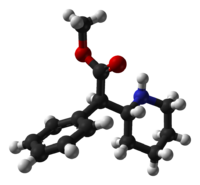Chemistry:Dexmethylphenidate
 | |
 | |
| Clinical data | |
|---|---|
| Trade names | Focalin, Focalin XR, others |
| Other names | d-threo-methylphenidate (D-TMP) |
| AHFS/Drugs.com | Monograph |
| MedlinePlus | a603014 |
| License data | |
| Dependence liability | Physical: None; Psychological: High |
| Routes of administration | By mouth |
| ATC code | |
| Legal status | |
| Legal status |
|
| Pharmacokinetic data | |
| Bioavailability | 11–52% |
| Protein binding | 30% |
| Metabolism | Liver |
| Elimination half-life | 4 hours |
| Excretion | Kidney |
| Identifiers | |
| |
| CAS Number |
|
| PubChem CID | |
| IUPHAR/BPS | |
| DrugBank |
|
| ChemSpider | |
| UNII |
|
| KEGG | |
| ChEBI | |
| ChEMBL | |
| Chemical and physical data | |
| Formula | C14H19NO2 |
| Molar mass | 233.311 g·mol−1 |
| 3D model (JSmol) |
|
| |
| |
| | |
Dexmethylphenidate, sold under the brand name Focalin among others, is a potent central nervous system (CNS) stimulant used to treat attention deficit hyperactivity disorder (ADHD) in those over the age of five years.[3] It is taken by mouth.[3] The immediate release formulation lasts up to five hours while the extended release formulation lasts up to twelve hours.[4] It is the more active enantiomer of methylphenidate.[3]
Common side effects include abdominal pain, loss of appetite, and fever.[3] Serious side effects may include abuse, psychosis, sudden cardiac death, mania, anaphylaxis, seizures, and dangerously prolonged erection.[3] Safety during pregnancy and breastfeeding is unclear.[5] Dexmethylphenidate is a central nervous system (CNS) stimulant.[6][3] How it works in ADHD is unclear.[3]
Dexmethylphenidate was approved for medical use in the United States in 2001.[1] It is available as a generic medication.[3] In 2020, it was the 130th most commonly prescribed medication in the United States, with more than 4 million prescriptions.[7][8]
Medical uses
Dexmethylphenidate is used as a treatment for ADHD, usually along with psychological, educational, behavioral or other forms of treatment. It is proposed that stimulants help ameliorate the symptoms of ADHD by making it easier for the user to concentrate, avoid distraction, and control behavior. Placebo-controlled trials have shown that once-daily dexmethylphenidate XR was effective and generally well tolerated.[6]
Improvements in ADHD symptoms in children were significantly greater for dexmethylphenidate XR versus placebo.[6] It also showed greater efficacy than osmotic controlled-release oral delivery system (OROS) methylphenidate over the first half of the laboratory classroom day but assessments late in the day favoured OROS methylphenidate.[6]
Contraindications
{{#section-h:Methylphenidate|Contraindications}}
Adverse effects
Products containing dexmethylphenidate have a side effect profile comparable to those containing methylphenidate.[9] {{#section-h:Methylphenidate|Adverse effects}}
Interactions
{{#section-h:Methylphenidate|Interactions}}
Mode of activity
Methylphenidate is a catecholamine reuptake inhibitor that indirectly increases catecholaminergic neurotransmission by inhibiting the dopamine transporter (DAT) and norepinephrine transporter (NET),[10] which are responsible for clearing catecholamines from the synapse, particularly in the striatum and meso-limbic system.[11] Moreover, it is thought to "increase the release of these monoamines into the extraneuronal space."[2]
Although four stereoisomers of methylphenidate (MPH) are possible, only the threo diastereoisomers are used in modern practice. There is a high eudysmic ratio between the SS and RR enantiomers of MPH. Dexmethylphenidate (d-threo-methylphenidate) is a preparation of the RR enantiomer of methylphenidate.[12][13] In theory, D-TMP (d-threo-methylphenidate) can be anticipated to be twice the strength of the racemic product.[10][14]
| Compd[15] | DAT (Ki) | DA (IC50) | NET (Ki) | NE (IC50) |
|---|---|---|---|---|
| D-TMP | 161 | 23 | 206 | 39 |
| L-TMP | 2250 | 1600 | >10K | 980 |
| DL-TMP | 121 | 20 | 788 | 51 |
Pharmacology
Dexmethylphenidate has a 4–6 hour duration of effect. A long-acting formulation, Focalin XR, which spans 12 hours is also available and has been shown to be as effective as DL (dextro-, levo-)-TMP (threo-methylphenidate) XR (extended release) (Concerta, Ritalin LA), with flexible dosing and good tolerability.[16][17] It has also been demonstrated to reduce ADHD symptoms in both children[18] and adults.[19] d-MPH has a similar side-effect profile to MPH[9] and can be administered without regard to food intake.[20]
See also
- Serdexmethylphenidate/dexmethylphenidate
Notes
References
- ↑ 1.0 1.1 "Focalin- dexmethylphenidate hydrochloride tablet". 24 June 2020. https://dailymed.nlm.nih.gov/dailymed/drugInfo.cfm?setid=7c552f11-e24a-4d9b-bb8d-be10c928eca8.
- ↑ 2.0 2.1 "Focalin XR- dexmethylphenidate hydrochloride capsule, extended release". 27 June 2020. https://dailymed.nlm.nih.gov/dailymed/drugInfo.cfm?setid=1a1da905-42a0-4748-9c39-67eca45deccc.
- ↑ 3.0 3.1 3.2 3.3 3.4 3.5 3.6 3.7 "Dexmethylphenidate Hydrochloride Monograph for Professionals". American Society of Health-System Pharmacists. https://www.drugs.com/monograph/dexmethylphenidate-hydrochloride.html.
- ↑ Mosby's Drug Reference for Health Professions - E-Book. Elsevier Health Sciences. 2013. p. 455. ISBN 9780323187602. https://books.google.com/books?id=41z07XtCfa0C&pg=PA455.
- ↑ "Dexmethylphenidate Use During Pregnancy". https://www.drugs.com/pregnancy/dexmethylphenidate.html.
- ↑ 6.0 6.1 6.2 6.3 "Dexmethylphenidate extended release: a review of its use in the treatment of attention-deficit hyperactivity disorder". CNS Drugs 23 (12): 1057–83. December 2009. doi:10.2165/11201140-000000000-00000. PMID 19958043.
- ↑ "The Top 300 of 2020". https://clincalc.com/DrugStats/Top300Drugs.aspx.
- ↑ "Dexmethylphenidate Hydrochloride - Drug Usage Statistics". https://clincalc.com/DrugStats/Drugs/DexmethylphenidateHydrochloride.
- ↑ 9.0 9.1 "Dexmethylphenidate". Drugs 62 (13): 1899–904; discussion 1905–8. 2002. doi:10.2165/00003495-200262130-00009. PMID 12215063.
- ↑ 10.0 10.1 "Differential pharmacokinetics and pharmacodynamics of methylphenidate enantiomers: does chirality matter?". Journal of Clinical Psychopharmacology 28 (3 Suppl 2): S54-61. June 2008. doi:10.1097/JCP.0b013e3181733560. PMID 18480678.
- ↑ "[3H]Threo-(+/-)-methylphenidate binding to 3,4-dihydroxyphenylethylamine uptake sites in corpus striatum: correlation with the stimulant properties of ritalinic acid esters". Journal of Neurochemistry 45 (4): 1062–70. October 1985. doi:10.1111/j.1471-4159.1985.tb05524.x. PMID 4031878.
- ↑ "Chiral drugs: comparison of the pharmacokinetics of [11Cd-threo and L-threo-methylphenidate in the human and baboon brain"]. Psychopharmacology 131 (1): 71–8. May 1997. doi:10.1007/s002130050267. PMID 9181638. https://zenodo.org/record/1232627.
- ↑ "Brain kinetics of methylphenidate (Ritalin) enantiomers after oral administration". Synapse 53 (3): 168–75. September 2004. doi:10.1002/syn.20046. PMID 15236349.
- ↑ "Stereoselective effects of methylphenidate on motor hyperactivity in juvenile rats induced by neonatal 6-hydroxydopamine lesioning". Psychopharmacology 160 (1): 92–8. February 2002. doi:10.1007/s00213-001-0962-5. PMID 11862378.
- ↑ "Methylphenidate and its ethanol transesterification metabolite ethylphenidate: brain disposition, monoamine transporters and motor activity". Behavioural Pharmacology 18 (1): 39–51. February 2007. doi:10.1097/FBP.0b013e3280143226. PMID 17218796.
- ↑ "Dexmethylphenidate extended-release capsules for attention deficit hyperactivity disorder". Expert Review of Neurotherapeutics 5 (4): 437–41. July 2005. doi:10.1586/14737175.5.4.437. PMID 16026226.
- ↑ "Open-label study of dexmethylphenidate hydrochloride in children and adolescents with attention deficit hyperactivity disorder". Journal of Child and Adolescent Psychopharmacology 14 (4): 555–63. 2004. doi:10.1089/cap.2004.14.555. PMID 15662147.
- ↑ "A double-blind, placebo-controlled withdrawal trial of dexmethylphenidate hydrochloride in children with attention deficit hyperactivity disorder". Journal of Child and Adolescent Psychopharmacology 14 (4): 542–54. Winter 2004. doi:10.1089/cap.2004.14.542. PMID 15662146.
- ↑ "Efficacy and safety of dexmethylphenidate extended-release capsules in adults with attention-deficit/hyperactivity disorder". Biological Psychiatry 61 (12): 1380–7. June 2007. doi:10.1016/j.biopsych.2006.07.032. PMID 17137560.
- ↑ "A single-dose, two-way crossover, bioequivalence study of dexmethylphenidate HCl with and without food in healthy subjects". Journal of Clinical Pharmacology 44 (2): 173–8. February 2004. doi:10.1177/0091270003261899. PMID 14747426.
Cite error: <ref> tag with name "Daytrana FDA label" defined in <references> is not used in prior text.
<ref> tag with name "Concerta FDA label" defined in <references> is not used in prior text.External links
- "Dexmethylphenidate". Drug Information Portal. U.S. National Library of Medicine. https://druginfo.nlm.nih.gov/drugportal/name/dexmethylphenidate.
- "Dexmethylphenidate hydrochloride". Drug Information Portal. U.S. National Library of Medicine. https://druginfo.nlm.nih.gov/drugportal/name/dexmethylphenidate%20hydrochloride.
 |

